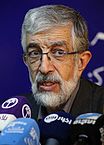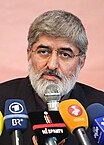Iranian legislative election, 2016
|
|
|||||||||||||||||||||||||||||||||||||||||||||||||||
|
|||||||||||||||||||||||||||||||||||||||||||||||||||
|
|||||||||||||||||||||||||||||||||||||||||||||||||||
|
|
|||||||||||||||||||||||||||||||||||||||||||||||||||
|
|||||||||||||||||||||||||||||||||||||||||||||||||||
|
|||||||||||||||||||||||||||||||||||||||||||||||||||
Parliamentary elections were held in Iran on 26 February 2016 to elect members of the Islamic Consultative Assembly for all seats in the 10th parliamentary election in the Islamic Republic era, and the 35th since the Persian Constitutional Revolution. A second round was held on 29 April 2016 for some constituencies where candidates failed to obtain the required minimum 25 percent of votes cast. The elected MPs will serve from May 28, 2016 to May 27, 2020.
The election was held as part of a general election which also elected members of the Assembly of Experts. This election was the first time that both bodies were elected simultaneously.
There were 54,915,024 registered voters (in Iran, the voting age is 18). More than 12,000 people filed to run for office. Nomination of 5,200 of candidates, mostly Reformists, were rejected by the Guardian Council and 612 individuals withdrew.
The 290-seat Islamic Consultative Assembly has 285 directly elected members and five seats reserved for the Zoroastrians, Jews, Assyrian and Chaldean Christians and Armenians (one for Armenians in the north of Iran and one for Armenians in the south).
...
Wikipedia




